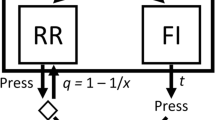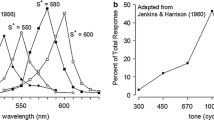Abstract.
Rationale: Previous experiments have shown that d-amphetamine disrupts timing behaviour in rats. It has been proposed that d-amphetamine's effects reflect a reduction in the period of the pacemaker of the hypothetical internal clock. However, some studies have obtained conflicting results. Objective: To examine the effects of d-amphetamine (0.2, 0.4, 0.8 mg kg–1 i.p.) on performance on two quantitative timing schedules: a free-operant schedule, in which rats were trained to distribute their responses differentially between two levers during the course of a 50-s trial (free-operant psychophysical procedure), and a discrete-trials schedule, in which rats were trained to discriminate the duration of light stimuli (interval bisection task). Methods: In experiment 1, rats were trained under the free-operant psychophysical procedure to respond on two levers (A and B) in 50-s trials in which reinforcement was provided intermittently for responding on A during the first half and on B during the second half of the trial. For one group, repetitive switching between levers was permitted; for another group, it was prevented. In experiment 2, rats were exposed to press lever A after a 2-s stimulus and lever B after an 8-s stimulus, and were then tested with stimuli of intermediate duration. For one group, a 'poke response' (depression of a central tray flap) was required after stimulus presentation to effect lever presentation; for the other group, this requirement did not operate. In both experiments, quantitative indices of timing were derived from the psychophysical functions (%B responding vs time). Results: In experiment 1, d-amphetamine increased the Weber fraction and displaced the psychophysical curve to the left in both versions of the schedule, as well as producing rate-dependent suppression of responding. In experiment 2, d-amphetamine increased the Weber fraction in both versions of the task without displacing the curve. Conclusions: These results confirm the disruptive effect of d-amphetamine on timing. The results of experiment 1 are consistent with the proposal that the drug reduces the period of the hypothetical pacemaker. However, the results of experiment 2 do not support this suggestion. Taken together, the results support the notion that different neural mechanisms may be involved in timing tasks involving temporal distribution of responding and discrimination of the duration of exteroceptive stimuli.
Similar content being viewed by others
Author information
Authors and Affiliations
Additional information
Electronic Publication
Rights and permissions
About this article
Cite this article
Chiang, TJ., Al-Ruwaitea, A., Mobini, S. et al. The effect of d-amphetamine on performance on two operant timing schedules. Psychopharmacology 150, 170–184 (2000). https://doi.org/10.1007/s002130000422
Received:
Accepted:
Issue Date:
DOI: https://doi.org/10.1007/s002130000422




